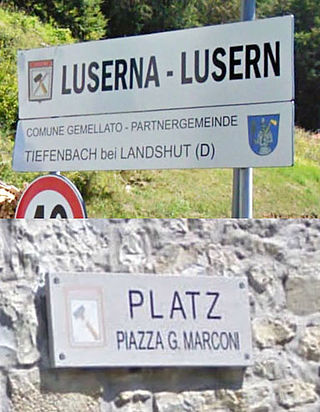Top Qs
Timeline
Chat
Perspective
Luserna
Comune in Trentino-Alto Adige/Südtirol, Italy From Wikipedia, the free encyclopedia
Remove ads
Luserna (Cimbrian: Lusérn, German: Lusern) is a comune (municipality) in Trentino in the northern Italian region Trentino-Alto Adige/Südtirol, located about 40 kilometres (25 mi) southeast of Trento. As 2021, it had a population of 271 and an area of 8.2 square kilometres (3.2 sq mi).[3]
Luserna is part of the Magnificent Community of the Cimbrian Highlands (Altipiani Cimbri) together with the municipalities of Lavarone and Folgaria. In the tourist sphere it is part of the Alpe Cimbra. It is one of I Borghi più belli d'Italia ("The most beautiful villages of Italy").[4]
Lusérn borders the following municipalities: Caldonazzo, Lavarone, Levico Terme, Pedemonte, Rotzo and Valdastico.
Remove ads
Cimbrian culture and language


Lusérn is the centre of Cimbrian language and culture. In the 2021 census, around 68,8% of the people of Lusérn stated Cimbrian, an Upper German dialect of the Germanic language, to be their first language.[5]
The Cimbrian spoken in Lusérn is a slightly different dialect from Cimbrian spoken elsewhere.[6]
Remove ads
Point of interest
The village of Luserna has seven restaurants and one little hotel, four museums (one of them is an old Austrian's Fortress) and four thematic trails that tell Cimbrian legends and stories. They are passable by families and mountain bikes, and in winter they become paths suitable for snowshoeing.[8]
Story
Summarize
Perspective
Luserna was founded around the year 1400 from Bavarians populations coming from nearby Lavarone who decided to stay and live here. In 1780 Luserna became independent from Lavarone. Until 1918 it was included in the Austro-Hungarian Empire, precisely in the County of Tyrol. During the last years of the 1800s it became famous for its tradition of bobbin lace and thanks to the Austrian administration, it had both German and Italian schools.
After the annexation to the Kingdom of Italy and with the advent of fascism, the people of Luserna were forbidden to speak Cimbro. This is because one of the dogmas of fascism was to Italianize every village and culture. This caused the phenomenon of the Options, an agreement between the Third Reich and the Kingdom of Italy to distribute the Mochen, Cimbrian and German populations who had lived for millennia in the ancient county of Tyrol, which later became the region of Venice Tridentine.
After the Second World War, thanks to the Gruber–De Gasperi Agreement, the Cimbrian linguistic minority of Luserna became part of the autonomy basis of the Autonomous Province of Trento and the Trentino - South Tyrol Region. In 1987 the Mocheno Cimbro Institute was founded and in 2001 the Cimbrian language was officially recognized within the regulations for the protection of Trentino linguistic minorities. In 2008, provincial legislation was implemented to protect the Ladin, Mochena and Cimbrian linguistic minorities settled in the Autonomous Province of Trento. Thanks to it, the Cimbrian community of Luserna now enjoys one of the most complete regulations in Europe. [9]
Demographic evolution

Notes and references
External links
Wikiwand - on
Seamless Wikipedia browsing. On steroids.
Remove ads




